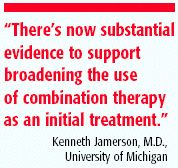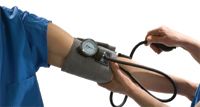New data support combo therapy at outset of hypertension treatment
New studies support the use of fixed dose antihypertensive combination therapy at the outset of hypertension treatment.
Among the various offerings at the American Society of Hypertension's 2007 annual meeting in Chicago, several new studies strongly supported the use of fixed-dose antihypertensive combination therapy at the outset of hypertension treatment.

A total of 12,600 hypertensive individuals with heart disease, renal disease, or target organ damage were randomized to either amlodipine and benazepril (5 mg and 20 mg) or benazepril and hydrochlorothiazide (20 mg and 12.5 mg). After one month, benazepril was increased to 40 mg in both groups. After the second month, amlodipine or thiazide doses were doubled. After the third month, investigators could add on any other drugs.
Impressive results

Though ACCOMPLISH was not a diabetes trial, 60% of patients had Type 2 diabetes. Jamerson noted that even in this hard-to-treat cohort, the combo therapies dropped mean systolic blood pressure (SBP) from 145.2 mmHg to 131.5 mmHg. The proportion of patients deemed well controlled (below 140/90 mmHg) went from 37.6% to 75.6%. "We more than doubled the number who are well controlled," said Jamerson. This was accomplished, in most cases, with the fixed-dose combos alone. Only 15% of patients needed an add-on drug; only 6% needed two. Adverse-event rates were few and mild, with dizziness, cough, and edema being the most common. Roughly 2% of patients became hypotensive.
"We assumed both combinations would reduce pressures down to target. Perhaps one is better than the other, but we are not really testing that," said Jamerson. He added, however, that combining a calcium-channel blocker (CCB) with an ACE inhibitor may increase nitric oxide production, thus improving vascular function.